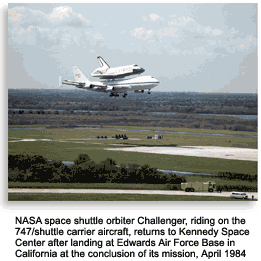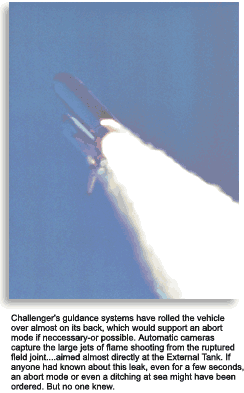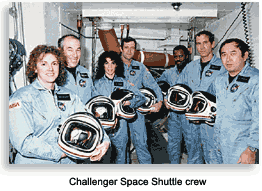The Space Shuttle Program was designed to replace single-use or expendable-launch rockets with reusable vehicles that would provide more economical access to outer space for government and private missions. The Challenger was the second member of the shuttle fleet. By the beginning of 1986, shuttle flights seemed nearly routine. Then on January 28, 1986, the Challenger exploded 74 seconds into its flight, which reminded the entire world of space exploration's true risks.
Columbia, launched in 1981, was the first space shuttle. It was followed a year later by Challenger. Challenger flew nine successful missions prior to January 1986. The shuttle was originally designed for 100 launches, or 10 years of operation. Challenger was the shuttle designated for Mission 51L and would be routine in many respects. It would carry cargo: the Tracking Data Relay Satellite-2 (TDRS-2), and a free-flying module designed to observe the tail and coma of Halley's comet with two ultraviolet spectrometers and two cameras.
 A unique aspect of the mission was one of its passengers. Christa McAuliffe, from Massachusetts, who had been selected from among more than 11,000 applicants, was to be the first teacher carried into space on the TISP, or Teacher In Space Program. The plan specified that McAuliffe would teach two lessons from space: The first would include an introduction to the crew members and their jobs, the cockpit, and human conditions on the shuttle. The second would explain how the shuttle flew, technological advances made through space exploration, and why space exploration is important.
The Challenger commander was Francis R. Scobee. The remainder of the crew consisted of pilot Michael J. Smith, mission specialists Ronald E. McNair, Ellison S. Onizuka, and Judith A. Resnik, and payload specialists McAuliffe and Gregory B. Jarvis.
Shuttle Mission 51L was plagued with problems from the beginning. Liftoff was scheduled for 3:43 p.m. EST on January 22, 1986. It first slipped to the 23rd, then the 24th, and finally to the 25th, on account of bad weather at the transoceanic abort landing site in Dakar, Senegal. Another 24 hours were lost when launch processing could not meet the new morning liftoff time, and a bad weather prediction at Kennedy Space Center resulted in yet another delay to 9:37 a.m. EST, January 27. Yet another 24 hours were added when problems developed with the orbiter hatch. Finally, on the morning of the 28th, a hardware interface module in the launch processing system failed during liquid hydrogen tanking. Two hours late, the mission launched. Seventy-four seconds later, Challenger exploded.
Pieces of the spacecraft plummeted about 10 miles before striking the ocean approximately 18 miles offshore. Debris continued to fall for an hour, making access to the crash site dangerous. The module containing the bodies of the crews was eventually located and retrieved. The identified remains were returned to their families. The unidentified remains were buried in Arlington National Cemetery.
A unique aspect of the mission was one of its passengers. Christa McAuliffe, from Massachusetts, who had been selected from among more than 11,000 applicants, was to be the first teacher carried into space on the TISP, or Teacher In Space Program. The plan specified that McAuliffe would teach two lessons from space: The first would include an introduction to the crew members and their jobs, the cockpit, and human conditions on the shuttle. The second would explain how the shuttle flew, technological advances made through space exploration, and why space exploration is important.
The Challenger commander was Francis R. Scobee. The remainder of the crew consisted of pilot Michael J. Smith, mission specialists Ronald E. McNair, Ellison S. Onizuka, and Judith A. Resnik, and payload specialists McAuliffe and Gregory B. Jarvis.
Shuttle Mission 51L was plagued with problems from the beginning. Liftoff was scheduled for 3:43 p.m. EST on January 22, 1986. It first slipped to the 23rd, then the 24th, and finally to the 25th, on account of bad weather at the transoceanic abort landing site in Dakar, Senegal. Another 24 hours were lost when launch processing could not meet the new morning liftoff time, and a bad weather prediction at Kennedy Space Center resulted in yet another delay to 9:37 a.m. EST, January 27. Yet another 24 hours were added when problems developed with the orbiter hatch. Finally, on the morning of the 28th, a hardware interface module in the launch processing system failed during liquid hydrogen tanking. Two hours late, the mission launched. Seventy-four seconds later, Challenger exploded.
Pieces of the spacecraft plummeted about 10 miles before striking the ocean approximately 18 miles offshore. Debris continued to fall for an hour, making access to the crash site dangerous. The module containing the bodies of the crews was eventually located and retrieved. The identified remains were returned to their families. The unidentified remains were buried in Arlington National Cemetery.
 Soon after the disaster, President Ronald Reagan spoke to the nation:
Soon after the disaster, President Ronald Reagan spoke to the nation:
Ladies and Gentlemen, I'd planned to speak to you tonight to report on the state of the Union, but the events of earlier today have led me to change those plans. Today is a day for mourning and remembering. Nancy and I are pained to the core by the tragedy of the shuttle Challenger. We know we share this pain with all of the people of our country. This is truly a national loss. Nineteen years ago, almost to the day, we lost three astronauts in a terrible accident on the ground. But we've never lost an astronaut in flight. We've never had a tragedy like this. And perhaps we've forgotten the courage it took for the crew of the shuttle. But they, the Challenger Seven, were aware of the dangers, but overcame them and did their jobs brilliantly. We mourn seven heroes: Michael Smith, Dick Scobee, Judith Resnik, Ronald McNair, Ellison Onizuka, Gregory Jarvis, and Christa McAuliffe. We mourn their loss as a nation together.Reagan appointed the Presidential Commission on the Space Shuttle Challenger Accident, better known as the Rogers Commission after its chairman, William P. Rogers. The commission's first task was to retrieve as much physical evidence as possible. Twenty-two ships, six submersibles and 33 aircraft participated in a search that covered about 93,000 square miles of ocean to a depth of 1,200 feet. About 50 percent of the total vehicle was recovered, including parts of the external tank (ET), both solid rocket boosters and the orbiter. About 45 percent of the orbiter itself was recovered, including all three main engines, which were recovered intact. The condition of the orbiter debris led to the conclusion that the orbiter itself did not explode, but was torn apart by aerodynamic stress after the ET structural failure. The orbiter's three main engines showed no signs that they contributed to the accident. An assessment of the ET debris suggested that the ET was not responsible for the accident. The primary suspect was an "O" ring. Evidence suggested that in the cold weather on that January morning, which at 36 degrees Fahrenheit was 15 degrees lower than at the launch of any previous shuttle, the "O" ring did not perform its function. The possibility that temperature had been a factor was still being debated when, in one of the notable moments during the commission's public hearings, physicist and commission member Richard Feynman placed a comparable "O" ring in a glass of ice water, removed it after a few minutes and squeezed it. When he let go, the ring did not immediately return to its original shape.
 The Rogers Commission presented its report on June 6, 1986. It stated that,
The Rogers Commission presented its report on June 6, 1986. It stated that,
"The cause of the Challenger accident was the failure of the pressure seal in the aft field joint of the right solid rocket motor. The failure was due to a faulty design rendering the seal unacceptably sensitive to a number of factors. These factors include the effects of temperature, physical dimensions, the character of materials, the effects of reuse and processing, and the reaction of the joint to dynamic loading."A week later, President Reagan directed NASA to develop plans to implement the commission's recommendations. On July 14, NASA delivered a timetable for doing so. Changes to equipment and procedures delayed the next shuttle mission until September 1988. In the aftermath of the disaster, the military abandoned plans to use the space shuttle to deliver military missions into space. As a result, the shuttle launch site at Vandenberg Air Force Base, in California, was terminated. In January 1987 the recovered remains of Space Shuttle Challenger were transported to an abandoned launch complex at Cape Canaveral Air Station in Florida. They were sealed in two 80-foot-deep Minuteman missile silos and adjacent underground equipment rooms, where they remain.